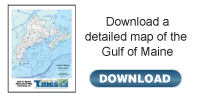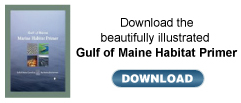In the News
Genetics sorts local from alien seaweed
By Rebecca Zeiber
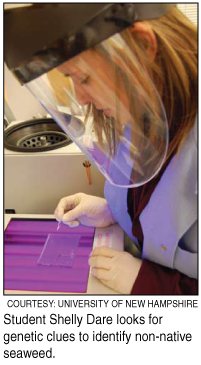 Beach combing on a frigid, blustery New England winter day
might not be a very popular activity, but for researchers at the
University of New Hampshire, or UNH, it’s helping to solve
a scientific puzzle in the seaweed world. The mystery involves
a “who’s who” in which two plant types may look
the same but are vastly different. One type is native, while the
other came from Japan, perhaps carried by shellfish or the hulls
of ships or spread by growers of the seaweed in certain areas
off the Northeast U.S. coast. Beach combing on a frigid, blustery New England winter day
might not be a very popular activity, but for researchers at the
University of New Hampshire, or UNH, it’s helping to solve
a scientific puzzle in the seaweed world. The mystery involves
a “who’s who” in which two plant types may look
the same but are vastly different. One type is native, while the
other came from Japan, perhaps carried by shellfish or the hulls
of ships or spread by growers of the seaweed in certain areas
off the Northeast U.S. coast.
The first piece of the puzzle involves collecting samples.
Jeremy Nettleton, a master’s candidate in plant biology at
the university, searches for red seaweed (genus Porphyra)
along the intertidal zone. From December through May, Nettleton
travels to sites along the New England coast to collect long blades
of Porphyra. Conducting field research during the winter
is a necessity, since that is when it is easiest to find the blades.
Back at the lab, Shelly Dare, also a master’s candidate
in plant biology, searches through seaweed specimens from regional
herbariums to determine if previously collected samples were misidentified
and to find out how long each species has been growing in a particular
region. These two students, along with their advisors Art Mathieson
and Chris Neefus, both UNH professors of plant biology, often
work side by side in the field and the lab. They are investigating Porphyra in New England as part of a New Hampshire Sea
Grant-funded project.
The puzzle involves sorting out red seaweed species. Researchers,
resource managers and others are concerned over whether or not
many of the Porphyra species found in New England are originally
from the region or if they are instead a Japanese cultivar, a
plant variety propagated for specific traits. This concern stems
from the potential of non-native species to use the habitat and
resources necessary for the survival of native plants.
Porphyra is commonly known by the Japanese name “nori”
and is the seaweed used to make sushi, Neefus explained. It is
grown on nets in Asia to supply the $1.2 billion per year nori
industry, he said, but has escaped and become widely established
in natural habitats.
“This cultivar is selected to grow more quickly and have
larger blades, and it is more likely to outcompete native species
if environmental conditions are favorable,” Nettleton added.
Therefore, it is important to determine their current and historical
distribution in New England. This requires comparing both new
samples and specimens collected years ago from the same region.
Many of the old samples were misidentified, so seaweed thought
to be native might actually have been the Japanese cultivar.
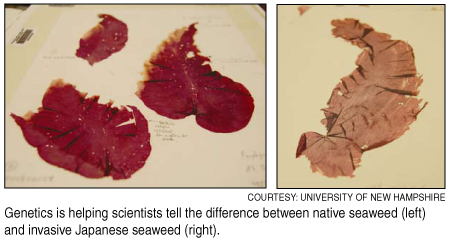
“I can’t tell the difference between the native species
and the Japanese cultivar by sight,” Dare laughed, and she
works with them every day. The morphological traits are too similar,
she said, and thus genetic analyses are necessary to separate
the two.
“My samples are pretty fresh, so it’s easy to conduct
molecular analyses on them,” said Nettleton. However, the
older herbarium samples that Dare works with are not always in
as good a condition. This makes the task of sorting out native
versus cultivar more difficult.
DNA sequencing of the species requires being able to compare
present-day samples collected throughout the coastal regions of
New England with species collected from the region in the past.
This enables researchers to determine if new species have begun
colonizing the region or if samples from the past were simply
misidentified. It is possible that a species considered to be
a newcomer to the area has actually been here for quite a long
time, Mathieson said.
This research requires going back to historical collections
of seaweeds held in herbariums where samples are kept from 200
years ago in some cases, rehydrating the samples, and then doing
genetic analyses on a small piece of the old seaweed.
Once analyses are conducted on both the old and new samples,
the genetics can be compared to see if a Japanese cultivar has
been introduced recently and is spreading or if it was here hundreds
of years ago without scientists knowing it. However, it can be
extremely difficult to determine how a species came to be in a
particular region. The Japanese cultivar tends to have narrower
blades. The genetic analysis indicates there may be different
chromosome counts for different Porphyra species, but more
research is needed.
The goal is to determine the potential impacts the Japanese
cultivar might have on native species. Once this puzzle is more
complete, the information will be used to improve management along
the coast of New England.
“We want to inform coastal managers about the threat that
the Japanese cultivar may or may not pose to native plant species,
and then help managers decide what actions they should or should
not take as a result,” Nettleton added.
Rebecca Zeiber writes for New Hampshire Sea Grant in Durham,
New Hampshire.
[ back to top of page ]
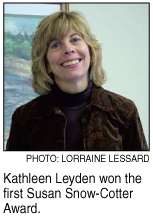 Maine coastal manager wins Susan Snow-Cotter Award Maine coastal manager wins Susan Snow-Cotter Award
Kathleen Leyden, coastal planning manager in the Maine State Planning Office, was awarded the first Susan Snow-Cotter Award for Excellence in Coastal & Marine Resource Management by the National Oceanographic and Atmospheric Administration (NOAA). She received the award at a ceremony in late February in Washington, DC. NOAA will present the annual award to honor people for outstanding contributions in helping the nation maintain healthy coastal and ocean resources. Susan Snow-Cotter, former director of the Massachusetts Coastal Zone Management and a tireless environmental advocate, died in late 2006 (see Gulf of Maine Times, Winter/Spring 2007, Page 2).

 [ back to top of page ] [ back to top of page ]
The Presumpscot: A river in recovery
By Matt Craig
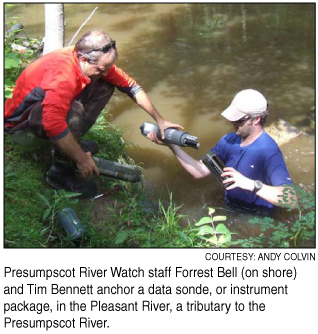 For decades, locals turned their backs to the Presumpscot River,
the largest freshwater source to Casco Bay in Maine. One of the
earliest industrialized rivers in New England, the Presumpscot
was notorious for emitting noxious fumes, some might say, strong
enough to peel the paint off of those houses unfortunate enough
to be built near its shores. For decades, locals turned their backs to the Presumpscot River,
the largest freshwater source to Casco Bay in Maine. One of the
earliest industrialized rivers in New England, the Presumpscot
was notorious for emitting noxious fumes, some might say, strong
enough to peel the paint off of those houses unfortunate enough
to be built near its shores.
Despite its polluted past, or perhaps because of it, the river
also has known many allies, including former Senator George Mitchell
(Dem., former Senate Majority Leader), who once declared, “It’s
not often we’re given a second chance with something as fragile
as a river. Let’s keep working on it. After all, the Presumpscot
River has worked hard in the service of mankind for hundreds of
years. It’s time we returned that favor.”
Recently, concerned stakeholders have joined with municipalities,
non-governmental organizations, industry, and state and federal
agencies to do just that. In 1999, pulp mills ceased discharges
to the Presumpscot, dramatically improving water quality. In
2002, the Smelt Hill Dam, the lowest of the nine dams on the river,
was removed so the lower seven miles (11 kilometers) of the Presumpscot
and 100 miles (160 kilometers) of tributaries now flow freely
to Casco Bay, allowing unrestricted access for anadromous (sea-run)
fish. In 2005, a project to enhance fish passage at the Highland
Lake dam enabled the return of alewives to spawning grounds.
In 2007, citizen, industry and agency stakeholders reached a preliminary
agreement to restore fish passage at existing dams on the Presumpscot
main stem (see the Gulf of Maine Times, Fall 2007).
Even the historical pollution has served as an unlikely ally
to keep the land undeveloped. That land along the river corridor
today presents unique opportunities for land protection adjacent
to urban areas.
To address the need for further water quality improvements
that promote the return of native fish species, the Casco Bay
Estuary Partnership, in collaboration with the Presumpscot River
Watershed Coalition, was awarded a $740,000 U.S. Environmental
Protection Agency Targeted Watershed grant in 2005.
As part of the Presumpscot Watershed Initiative, farmers have
volunteered to steer livestock away from tributaries toward alternate
watering systems to prevent fecal contamination. Youth conservation
corps have restored riparian buffers and mitigated decades of
erosion while fostering stewardship in their communities. Watershed
golf courses have agreed to strive for Audubon International Sanctuary
certification to improve habitat, reduce water quality impacts
and appeal to the green-minded golfer.
Municipalities continue to commit substantial amounts of staff
time, equipment and materials to stabilize degraded stream crossings
and replace undersized culverts, while promoting yardscaping programs
that encourage residents to embrace low-impact lawn care. Students
are learning about the history and ecology of the river through
place-based experiential lessons. All the while, dedicated volunteers
are sampling water quality, complementing thousands of data points
and building a baseline of data for the future.
Despite centuries of intensive industrial use and pollution,
the citizens of the Presumpscot watershed are showing that it
is never too late to turn back to the river. The Presumpscot
is now a river in recovery.
Matt Craig is the technical program coordinator with the
Casco Bay Estuary Partnership in Portland, Maine.
For more information visit: http://presumpscotcoalition.org
[ back to top of page ]
Outside the Gulf
Fish think fast to catch prey: German researchers have modeled the compact neural circuitry that allows archerfish to make accurate and flexible decisions about its insect prey in a flash. The researchers chose the archerfish because it is known for its unique way of shooting its insect prey with water and making rapid-fire decisions about where it will land. The fish pinpoints its prey in a four-dimensional space and maps it precisely onto a fine-tuned, two-dimensional motor space. In another set of experiments, the simple archerfish network also had to choose the most rewarding target out of two and decide when a response is likely to succeed, the researchers reported. The circuitry must be tuned on the basis of what the fish have learned previously.
“Small Circuits for Large Tasks: High-Speed Decision-Making in Archerfish,” by T. Schlegel; S. Schuster at Universitat Erlangen-Nurnberg Institut fur Zoologie II in Erlangen, Germany. Science, January 4, 2008, 1149265, 104-106.
Migratory birds can compensate for longitude. Eurasian reed warblers captured during their spring migrations and released after being flown 1,000 kilometers (621 miles) to the east can correct their travel routes and head for their original destinations, researchers reported in the online version of Current Biology on Jan. 31. The new evidence suggests that the birds have true navigation, meaning that they can identify at least two coordinates that roughly correspond to geographic latitude and longitude. The findings challenge the notion held by some that birds might be limited to navigation in the north-south direction. But scientists still don’t know how they do it.
Chernetsov et al.: “A Long-Distance Avian Migrant Compensates for Longitudinal Displacement during Spring Migration,” Chernetsoy, et. al., Current Biology 18, 1–3, February 12, 2008.
[ back to top of page ]
From the Scientific Literature
The ocean’s uneven heat gain: While overall temperature in the North Atlantic Ocean has risen over the past half century, it has not been consistent across the area, researchers reported in the journal Science. This example fits with the general pattern of global warming, but before scientists can accurately predict what the impacts of warming will be, they need to understand the spatial pattern of temperature change. The researchers found that in the North Atlantic, the tropics and subtropics have warmed, but the subpolar ocean has cooled over the last 50 years. Using an ocean general circulation model, they interpret the change as mostly the result of wind and buoyancy forcing associated with the North Atlantic Oscillation, which is a climate phenomenon caused by differences in sea-level pressures.
The researchers suggest that while the spatial pattern of temperature change in the North Atlantic does not directly reflect global warming, it may be the indirect result of warming as transmitted through large-scale changes in atmospheric circulation.
“The Spatial Pattern and Mechanisms of Heat Content Change in the North Atlantic,” by M.S. Lozier; M.S.C. Reed; N.J. Moore at Duke University in Durham, NC; S. Leadbetter; R.G. Williams; V. Roussenov at Liverpool University in Liverpool, UK; and N.J. Moore at Michigan State University in East Lansing, MI, Science, January 3, 2008, 1146436v1.
How diatoms build their shells: Diatoms, some of which are so tiny that 30 can fit across the width of a human hair, are so numerous that they are among the key organisms taking the greenhouse gas carbon dioxide out of the Earth’s atmosphere. The shells of diatoms are so heavy that when they die in the oceans they typically sink to watery graves on the seafloor, taking carbon out of the surface waters and locking it into sediments below. Scientists reported in the online edition of the Proceedings of the National Academy of Sciences their discovery of whole subsets of genes and proteins that govern how one species of diatom builds its shell. For oceanographers, the work might one day help them understand how thousands of different kinds of diatoms—and their ability to remove carbon dioxide from the atmosphere—might be affected by something like global climate change. The new work took advantage of the genomic map of the diatom Thalassiosira pseudonana published in 2004 by a team led by University of Washington oceanography Professor Virginia Armbrust, who is a corresponding author of this paper.
“Whole-genome expression profiling of the marine diatom Thalassiosira pseudonana identifies genes involved in silicon bioprocesses,” Mock et. al. Proceedings of the National Academy of Sciences, 2008; 0: 0707946105v1-0.
[ back to top of page ]
|






